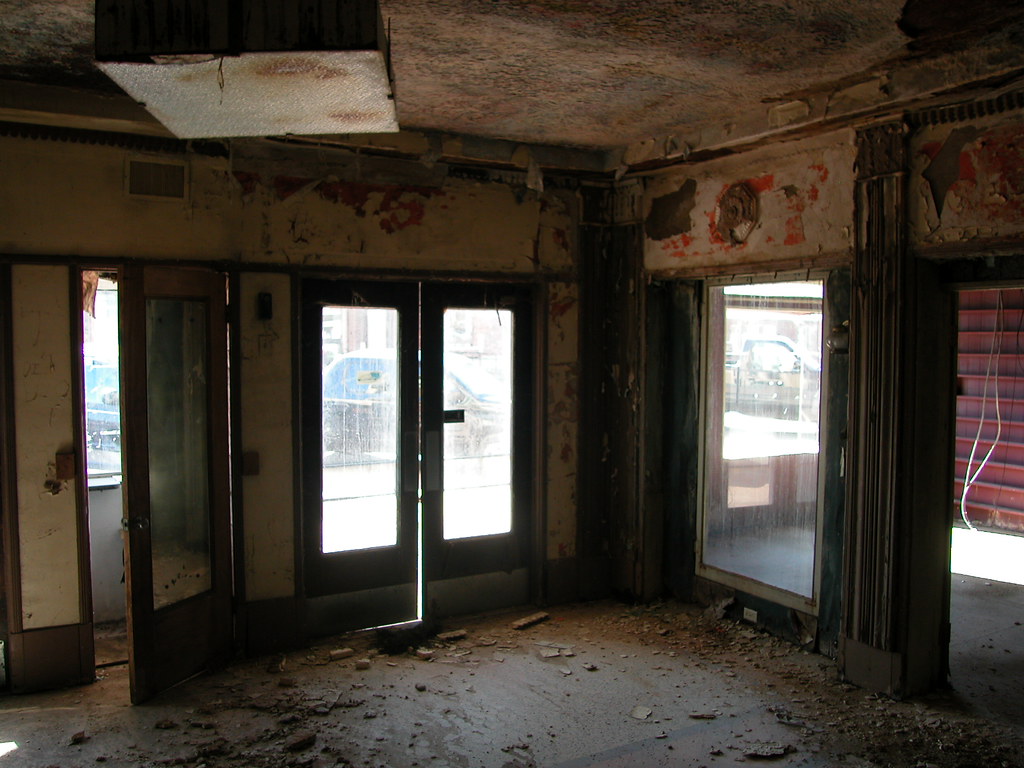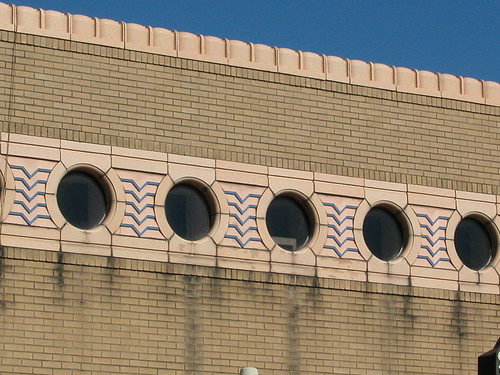by Michael R. Allen

Photographic collage by Eric Seelig.
LOCATION: 8601 St. Clair Ave.; Caseyville, Illinois
ORIGINAL NAME: East St. Louis Drive-In
ORIGINAL OPERATOR: Publix Great States Theatres
DATE OF CONSTRUCTION: 1942
DATES OF ABANDONMENT: 1992 – 2005
DATES OF DEMOLITION: August – December 2005
The decrepit and broken floorboards of the ticket office at the French Village Drive-In near East Saint Louis don’t look like a place of terror. For anyone who has spent time around broken-down buildings and abandoned places, the ticket office building doesn’t seem very remarkable save its streamlined, late Art Deco facade. Yet only a few years ago, in November 2000, police recovered the body of a missing East Saint Louis dentist, Kenneth Long, in this vacant space. His body was stashed in the ticket office — on the floor — where it lay until its staunch smell disturbed residents of nearby homes. The residents called the police, who came to find the gruesome source.
Perhaps it is somehow fitting that the French Village Drive-In was then and still is the property of a church congregation, the Church of the Living God of Fairview Heights. The forces of abandonment forge unlikely and unsettling relationships and transform functional spaces into locations of intense historical mutation. Add to the mix the possibility that Dr. Long himself had seen a film at the Drive-In and that many of his patients had also attended screenings at the Drive-In, and the story begins to raise many connections whose significance is uncertain yet troubling. Here is a place built to stimulate the collective imagination becoming the scene of almost-cinematic carnage: the dead body in the abandoned drive-in theater ticket office. What could be more disturbing or fantastic to anyone who had seen a movie, perhaps one involving dead bodies being discovered in foggy and forgotten places?

Still, the French Village Drive-In retains a more direct importance. From its opening in 1942 until its close fifty years later, the French Village Drive-In — originally named for East St. Louis — provided entertainment and escape to thousands of East Siders. People such as my mother fondly remember a night spent gazing at the huge screen in the middle of farm fields, removed enough from the bustle of East St. Louis to provide some sense of getaway to the filmgoers.
J.P. Dromey of Publix Great States Theatres, Inc. opened the East St. Louis Drive-In as perhaps the first drive-in movie theater in the St. Louis area. The original capacity was 500 cars. It attracted local competition by 1949, when the noted Jablonow and Komm chain opened the now-demolished Mounds Drive-In Theatre at 7400 Collinsville Road. By the late 1950’s, the ownership fell into local hands, that of the Bloomer Amusement Company (BAC) of Belleville. BAC renamed the drive-in the French Village Drive-In, perhaps in response to the growing out-migration from East St. Louis. The theater was successful until the 1980’s, when the multi-theater format and home video technology lured people away from viewing an only-choice film under the sky.

Throughout its life, the theater’s stylish design enhanced its presence. Being a relatively early drive-in in the St. Louis area, the theater was constructed when patron and proprietor alike still wanted each movie theater, even a drive-in, to look as lavish as the movies it screened. The French Village Drive-In fulfilled these demands with its stately and colorful Art Deco style. The head-house, site of the ticket office, consists of a two-story, narrow center portion with projecting canopy wings for cars to pass through. All of the corners are heavily rounded, giving the building a space-age look that must have seemed quite sophisticated in 1942. Directly behind the head-house — symmetrically aligned — is the trapezoidal screen structure, which presents gray corrugated aluminum walls that are punctuated by lively red rectangles on the main facade.

The screen structure is unique for a drive-in theater in that its builders built it to accommodate stage as well as screen entertainment. The screen is fronted by a long, somewhat shallow stage. The screen is actually one wall of a building that houses a few dressing rooms, prop storage areas and various lighting controls. During the early days of the drive-in’s life, the stage was used often for pre-film and stand-alone live performance.
The screen and stage now look out upon a field of small trees that cloak the comparatively banal projection house. This field in winter appears to be occupied by countless skeletal forms instead of hundreds of east side filmgoers. Of course, the trees are far from deathly as they continue to grow strong in soil that must still be polluted from the exhaust of the thousands of vehicles that people parked there. Traces of the past use are embedded in the very earth here. The blank screen still commands one’s gaze from the field; something kinetic seems imminent there.

In front of the Drive-In is the outstanding although likely not original marquee, a concoction of red and yellow aluminum, neon tubing and the traditional white letter-board space. C. Bendsen Company of Decatur, Illinois made this marquee. The marquee. The marquee frames the words “French Village” in a three-color palate (green, yellow, blue) with accompanying paintbrush. This sign is imaginative — the subtle palate motif rather than an obvious Eiffel Tower image — and shows that the East Side’s aspirations have always been as grand and as accomplished as those of St. Louis. This drive-in is finer than almost any other that has stood in the St. Louis area. Certainly, its architecture proclaims a confident optimism that has been betrayed, however momentarily, by current events.
In the meantime, the French Village Drive-In awaits some future greater than that of body repository. It is owned by a Fairview Heights church that may seek to build a new church on its ground, but it will likely stand for years to come. Perhaps it may even reopen, beating the forces of history that led to its unbecoming and horrific misuse.

From a nearby hillside, one can catch a view that includes the barren theater grounds as well as the Gateway Arch. The French Village Drive-In came into this view first, before anyone would have predicted that anything much more modern could come along.
More information
Drive-Ins.com
The Web Yard
Cinema Treasures
A version of this article appeared under the same title in the Fall 2005 issue of the NewsLetter of the Society of Architectural Historians, Missouri Valley Chapter.


























